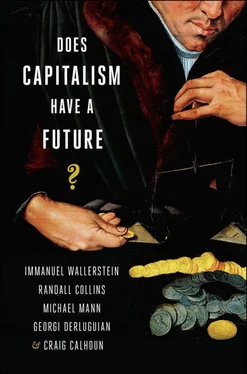Immanuel Wallerstein - Does Capitalism Have a Future?
Здесь есть возможность читать онлайн «Immanuel Wallerstein - Does Capitalism Have a Future?» весь текст электронной книги совершенно бесплатно (целиком полную версию без сокращений). В некоторых случаях можно слушать аудио, скачать через торрент в формате fb2 и присутствует краткое содержание. Город: New York, Год выпуска: 2013, ISBN: 2013, Издательство: Oxford University Press, Жанр: Публицистика, sci_economy, на английском языке. Описание произведения, (предисловие) а так же отзывы посетителей доступны на портале библиотеки ЛибКат.
- Название:Does Capitalism Have a Future?
- Автор:
- Издательство:Oxford University Press
- Жанр:
- Год:2013
- Город:New York
- ISBN:978-0-19-933084-3
- Рейтинг книги:5 / 5. Голосов: 1
-
Избранное:Добавить в избранное
- Отзывы:
-
Ваша оценка:
- 100
- 1
- 2
- 3
- 4
- 5
Does Capitalism Have a Future?: краткое содержание, описание и аннотация
Предлагаем к чтению аннотацию, описание, краткое содержание или предисловие (зависит от того, что написал сам автор книги «Does Capitalism Have a Future?»). Если вы не нашли необходимую информацию о книге — напишите в комментариях, мы постараемся отыскать её.
Does Capitalism Have a Future? — читать онлайн бесплатно полную книгу (весь текст) целиком
Ниже представлен текст книги, разбитый по страницам. Система сохранения места последней прочитанной страницы, позволяет с удобством читать онлайн бесплатно книгу «Does Capitalism Have a Future?», без необходимости каждый раз заново искать на чём Вы остановились. Поставьте закладку, и сможете в любой момент перейти на страницу, на которой закончили чтение.
Интервал:
Закладка:
The rub is on the expense side. The two main ways to pay for schooling (at all levels: elementary, secondary, tertiary, and whatever further levels become added on) are either by government provision or by private purchase. Both of these come under pressure in times of economic downturn and squeezed government revenue. In the years around 2010, both in the United States and many other countries, the costs of public education became such a substantial proportion of government budgets (especially at the local level) that they gave rise to movements to cut educational spending. In Chile, for instance, where 50% of the youth cohort now attends university, there is a struggle between the organized students demanding free university education for all and administrators and tax conservatives who push an increasing proportion of higher education into the private marketplace. Similar issues have roiled the student population in France and elsewhere. In the United States, where higher education is funded largely (and increasingly) by the students themselves and their families, there has been much concern over the amount of debt in the form of student loans—now (as of 2011) approaching 10% of GDP. If one extrapolates both the numbers of students extending their stay in schools in response to technological displacement, and the proportion of the economy made up by student debt, one can see that another twenty years or so of technological displacement and credential inflation will become enormously expensive to the system as a whole. What would happen if student debt rose to 50% of GDP, or 100%?
Education is a major cost of government, and this tends to limit future expansion. With higher costs, there are pressures to privatize, shifting the burden of funding to students or parents; but this too faces a limit as the middle class is economically squeezed. By 2012, there was a wave of publicity in the United States about what kinds of degrees are not worth the cost of acquiring them, in terms of the jobs one can get or one fails to get. Although one individual solution would simply be to drop out of the educational competition, the more popular choice among youth has been to seek specific vocational education, and there has been an upsurge of schools in areas like apparel design, computer programming, business, etc. But the shift to vocational education does not evade the dynamic of credential inflation, and we can predict increasing competition inside those vocational sectors, and rising inflation of vocational degrees. One indicator has been controversy, both in the political sphere and in accrediting and regulatory agencies, critiquing the low rate of job success for such vocational students, and denying them access to government loans. That is to say, the inflated value of educational degrees has become an explicit problem.
Information Technology is again being invoked as a solution. There is a rush toward university courses online, thereby achieving great economies of scale. Some of these are for sale, albeit at rates far lower than the cost of actual tuition at a bricks-and-mortar institution. Others are offered altruistically for free. Neither method will hinder credential inflation; indeed, both add to it, by putting still more educated persons on the market. As of now, the new kinds of credentials are being labeled as distinct from university degrees, and in that sense not directly competing with them. This remains to be seen; in effect a new form of cheap educational currency is being created, alongside a more traditional and expensive educational currency. If educational currencies are strictly like money, Gresham’s law would apply, and the cheap currency would drive out the expensive one. On the other hand, in economic sociology, as we know from Viviana Zelizer (1994) and Harrison White (2002), high-quality economic objects can exist in separate circuits alongside cheap ones, and that may well continue to be the case in the production of educational credentials.
The dilemma is this: efforts to make education cheaper have the effect of reducing employment in the educational sector itself; if a few famous universities monopolize teaching through online courses, and a few professors can do the vast amount of the teaching with electronic assistance, one more sector of employment becomes technologically displaced. The result is the same through the pathway of old-fashioned tax revolts; a short-term reduction in the population’s tax burden has the roundabout effect of reducing jobs available for that same population.
Of the five escape routes from capitalist crisis, continued educational inflation seems to me the most plausible. An expanding educational system driven by credential inflation reaches a potential crisis point within the educational system itself. This is not necessarily final. One can envision a series of such plateaus, stopping and restarting as our secular faith in salvation through education goes through disillusionment and revival. But if this becomes increasingly government sustained, it amounts to socialism in the guise of education. It is conceivable that liberal governments might find their way to keep expanding educational systems, using them as a Keynesian safety valve, and a form of transfer payments from the capitalists and the diminishing sector of the employed, to sustain the otherwise unemployed. But to get such a government might well take a near-revolutionary disillusionment with capitalism.
WHEN WILL FULL-BLOWN CRISIS HAPPEN?
Computerization of middle-class labor (since the last decade of the 20th century) is proceeding at a much faster pace than the mechanization of the manual labor force (which took approximately the entire 19th century and three-quarters of the 20th). Technological displacement of middle-class labor is not much more than twenty years old; whereas it took almost 200 years to destroy the working-class labor force.
Another estimate of the timing of future capitalist crisis is provided by world-system (W-S) theory. In earlier writing on the capitalist world-system, Wallerstein and colleagues presented a theoretical model of systemic long cycles. The core regions of the W-S in their expansive phase generate their advantage by resources extracted under favorable conditions from the periphery. Hegemony is periodically threatened by conflicts within the core, and especially by semiperipheral zones rising to threaten the hegemon. Eventually the core gets caught up with, just as increasing competition in a new area of entrepreneurial profit brings down the profits once gained by the early innovator; in this respect, the W-S operates like Schumpeter’s cycle of entrepreneurship, but on a global scale. With each new cycle, new opportunities for expansion and profit arise, under the leadership of a new hegemon. The crucial condition in the background, however, is that there must be an external area, outside the W-S, which can be incorporated and turned into the periphery of the system. Thus there is a final ending point to the W-S: when all the external areas have been penetrated. At this point the struggle for profit in the core and semiperiphery cannot be resolved by finding new economic regions to conquer. The W-S undergoes not just cyclical crisis but terminal transformation.
On the basis of past cycles, Wallerstein (also Arrighi, 1994) project the crisis of the W-S at approximately 2030–2045. My own estimate of the crisis point generated by the mechanism of technological displacement of the middle class depends on the rate at which structural unemployment grows. (This must be measured not merely in convenient technical terms such as, in the United States, the number of applications for unemployment compensation, but by our best measure of the proportion of the adult population unable to find work and driven out of the employment sector entirely.) An unemployment rate of 10% is painful, by American standards; 25% (found in crisis economies) is big trouble, but it has been sustained in the past. But when unemployment reaches 50% of the work-capable population, or 70%, the capitalist system must come under such pressure—both from underconsumption and political agitation—that it cannot survive. If we think such unemployment rates are unimaginable, let us imagine again, through the lens of technological displacement of all categories of work by electronic machinery. It is clear that the rate of technological displacement has accelerated in the last fifteen years. We could well reach 50% structural unemployment by the year 2040, and 70% not long after that. In gross terms, this agrees with the W-S projection of a terminal crisis of capitalism around the middle of the 21st century.
Читать дальшеИнтервал:
Закладка:
Похожие книги на «Does Capitalism Have a Future?»
Представляем Вашему вниманию похожие книги на «Does Capitalism Have a Future?» списком для выбора. Мы отобрали схожую по названию и смыслу литературу в надежде предоставить читателям больше вариантов отыскать новые, интересные, ещё непрочитанные произведения.
Обсуждение, отзывы о книге «Does Capitalism Have a Future?» и просто собственные мнения читателей. Оставьте ваши комментарии, напишите, что Вы думаете о произведении, его смысле или главных героях. Укажите что конкретно понравилось, а что нет, и почему Вы так считаете.












